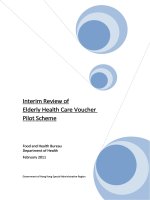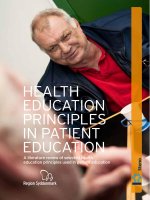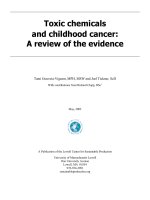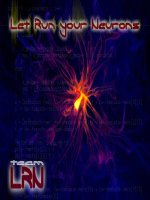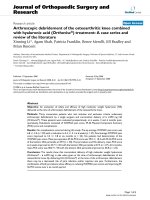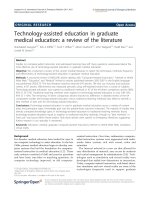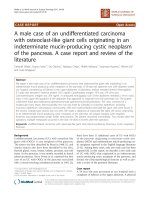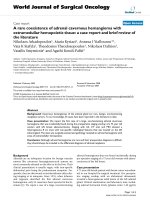Review of NASA’s Longitudinal Study of Astronaut Health docx
Bạn đang xem bản rút gọn của tài liệu. Xem và tải ngay bản đầy đủ của tài liệu tại đây (1.2 MB, 95 trang )
TEAM LRN
Review of NASA’s
Longitudinal Study
of Astronaut Health
David E. Longnecker
Frederick J. Manning
Melvin H.Worth, Jr.,
Editors
THE NATIONAL ACADEMIES PRESS
TEAM LRN
THE NATIONAL ACADEMIES PRESS
Washington, D.C.
www.nap.edu
David E. Longnecker, Frederick J. Manning,
and Melvin H. Worth, Jr., Editors
Committee on the Longitudinal Study of Astronaut Health
Board on Health Sciences Policy
REVIEW OF NASA’S
Longitudinal Study
AstronautHealth
OF
TEAM LRN
THE NATIONAL ACADEMIES PRESS • 500 Fifth Street, N.W. • Washington, DC 20001
NOTICE: The project that is the subject of this report was approved by the Governing
Board of the National Research Council, whose members are drawn from the councils of
the National Academy of Sciences, the National Academy of Engineering, and the
Institute of Medicine. The members of the committee responsible for the report were
chosen for their special competences and with regard for appropriate balance.
This study was supported by Contract/Grant No. NASW-03031 between the National
Academy of Sciences and the National Aeronautics and Space Administration. Any
opinions, findings, conclusions, or recommendations expressed in this publication are
those of the Institute of Medicine Committee on the Longitudinal Survey of Astronaut
Health and do not necessarily reflect the views of the organizations or agencies that
provided support for the project.
International Standard Book Number 0-309-09148-9 (Book)
International Standard Book Number 0-309-53016-4 (PDF)
Additional copies of this report are available from the National Academies Press, 500
Fifth Street, N.W., Lockbox 285, Washington, DC 20055; (800) 624-6242 or (202) 334-
3313 (in the Washington metropolitan area); .
Copyright 2004 by the National Academy of Sciences. All rights reserved.
Printed in the United States of America.
The serpent has been a symbol of long life, healing, and knowledge among almost all
cultures and religions since the beginning of recorded history. The serpent adopted as a
logotype by the Institute of Medicine is a relief carving from ancient Greece, now held by
the Staatliche Museen in Berlin.
TEAM LRN
TEAM LRN
The National Academy of Sciences is a private, nonprofit, self-perpetuating
society of distinguished scholars engaged in scientific and engineering research,
dedicated to the furtherance of science and technology and to their use for the
general welfare. Upon the authority of the charter granted to it by the Congress
in 1863, the Academy has a mandate that requires it to advise the federal
government on scientific and technical matters. Dr. Bruce M. Alberts is
president of the National Academy of Sciences.
The National Academy of Engineering was established in 1964, under the
charter of the National Academy of Sciences, as a parallel organization of
outstanding engineers. It is autonomous in its administration and in the
selection of its members, sharing with the National Academy of Sciences the
responsibility for advising the federal government. The National Academy of
Engineering also sponsors engineering programs aimed at meeting national
needs, encourages education and research, and recognizes the superior
achievements of engineers. Dr. Wm. A. Wulf is president of the National
Academy of Engineering.
The Institute of Medicine was established in 1970 by the National Academy of
Sciences to secure the services of eminent members of appropriate professions
in the examination of policy matters pertaining to the health of the public. The
Institute acts under the responsibility given to the National Academy of Sciences
by its congressional charter to be an adviser to the federal government and, upon
its own initiative, to identify issues of medical care, research, and education. Dr.
Harvey V. Fineberg is president of the Institute of Medicine.
The National Research Council was organized by the National Academy of
Sciences in 1916 to associate the broad community of science and technology
with the Academy’s purposes of furthering knowledge and advising the federal
government. Functioning in accordance with general policies determined by the
Academy, the Council has become the principal operating agency of both the
National Academy of Sciences and the National Academy of Engineering in
providing services to the government, the public, and the scientific and
engineering communities. The Council is administered jointly by both
Academies and the Institute of Medicine. Dr. Bruce M. Alberts and Dr. Wm. A.
Wulf are chair and vice chair, respectively, of the National Research Council.
www.national-academies.org
TEAM LRN
v
COMMITTEE ON THE
LONGITUDINAL STUDY OF ASTRONAUT HEALTH
DAVID E. LONGNECKER (Chair), Senior Vice President and Corporate
Chief Medical Officer and Robert D. Dripps Professor of Anesthesia,
University of Pennsylvania Health System, Philadelphia, Pennsylvania
ALFRED F. CONNORS, JR., Charles H. Rammelkamp Professor of
Medicine, Case Western Reserve University, and Chair, Department of
Medicine, MetroHealth Medical Center, Cleveland, Ohio
ROY L. DEHART, Director, Vanderbilt Center for Occupational and
Environmental Medicine, Nashville, Tennessee
R. J. MICHAEL FRY, Retired Head of Cancer Section, Oak Ridge National
Laboratory, Indianapolis, Indiana
DANIEL R. MASYS, Director of Biomedical Informatics and Professor of
Medicine, University of California, San Diego
VAN C. MOW, Stanley Dicker Professor of Biomedical Engineering and
Orthopaedic Bioengineering, and Chair, Department of Biomedical
Engineering, Columbia University, New York, New York
TOM S. NEUMAN, Professor of Clinical Medicine and Associate Director,
Emergency Medical Services, San Diego Medical Center, University of
California, San Diego
THOMAS F. OLTMANNS, Edgar James Swift Professor of Arts and Sciences,
Department of Psychology, Washington University, St. Louis, Missouri
RUSSELL B. RAYMAN, Executive Director, Aerospace Medical Association,
Arlington, Virginia
WALTER ROBINSON, Associate Professor of Pediatrics and Medical Ethics,
Division of Medical Ethics, Harvard Medical School, Boston,
Massachusetts
ELAINE RON, Senior Investigator, Radiation Epidemiology Branch, National
Cancer Institute, National Institutes of Health, Rockville, Maryland
CAROL SCOTT-CONNER, Chair, Department of Surgery, University of
Iowa Hospitals and Clinics, Iowa City, Iowa
M. RHEA SEDDON, Assistant Chief Medical Officer, Vanderbilt Medical
Group, Vanderbilt University Medical Center, Nashville, Tennessee
DEBORAH ZUCKER, Assistant Professor of Medicine, Tufts University and
Clinical Investigator, Division of Clinical Care Research, New England
Medical Center, Boston, Massachusetts
Study Staff
FREDERICK J. MANNING, Study Director
NATASHA S. DICKSON, Senior Project Assistant
BENJAMIN HAMLIN, Research Assistant
TEAM LRN
vi STAFF
Institute of Medicine Staff
ANDREW POPE, Director, Board on Health Sciences Policy
MELVIN H. WORTH, JR., Scholar-in-Residence
TROY PRINCE, Administrative Assistant, Board on Health Sciences Policy
CARLOS GABRIEL, Financial Associate
TEAM LRN
vii
INDEPENDENT REPORT REVIEWERS
This report has been reviewed in draft form by individuals chosen for their
diverse perspectives and technical expertise, in accordance with procedures
approved by the National Research Council’s Report Review Committee. The
purpose of this independent review is to provide candid and critical comments that
will assist the institution in making its published report as sound as possible and to
ensure that the report meets institutional standards for objectivity, evidence, and
responsiveness to the study charge. The contents of the review comments and draft
manuscript remain confidential to protect the integrity of the deliberative process.
We wish to thank the following individuals for their participation in the review of
this report:
John R. Ball, American Society for Clinical Pathology
John Boice, International Epidemiology Institute
F. Andrew Gaffney, Vanderbilt University
Thomas A. Louis, Johns Hopkins University
Jay H. Lubin, National Institutes of Health
Jonathan D. Moreno, University of Virginia
Deborah J. Wear-Finkle, Maine Cognitive Therapy Center
Although the reviewers listed above have provided many constructive
comments and suggestions, they were not asked to endorse the conclusions or
recommendations nor did they see the final draft of the report before its release.
The review of this report was overseen by ROBERT M. EPSTEIN, Harold
Carron Professor of Anesthesiology Emeritus at the University of Virginia,
appointed by the Institute of Medicine, who was responsible for making certain
that an independent examination of this report was carried out in accordance
with institutional procedures and that all review comments were carefully
considered. Responsibility for the final content of this report rests entirely with
the authoring committee and the institution.
TEAM LRN
TEAM LRN
ix
Preface
As part of its ongoing commitment to the nation’s space program, NASA’s
medical leadership asked the Institute of Medicine (IOM) to review specific
aspects of the scientific basis, policies, and procedures associated with the
Longitudinal Study of Astronaut Health (LSAH). NASA created the LSAH in
1992 to address a variety of issues, including both the health of astronauts
during space flight and the longer-term health issues that might be associated
with space flight and flight training.
The IOM Committee on the LSAH held most of its deliberations at the new
IOM facilities in Washington, DC, where the group pondered a variety of health
care issues related to space flight, astronaut training, and subsequent astronaut
health. We spent many hours developing an in-depth understanding of the
LSAH, the major risk factors related to space flight and flight training, and the
subsequent health of astronauts. The highlight of the committee’s experiences
took place at the Kennedy Space Center (KSC) on January 15-16, 2003, when
the committee met with numerous NASA scientists associated with the LSAH,
all of whom were gathered at KSC for the scheduled launch of STS-107, the
Columbia orbiter flight devoted to life sciences. The committee heard numerous
scientific presentations on January 15, including those by the flight surgeons
associated with the STS-107 Columbia crew. After an informative session of
scientific presentations and deliberations, the committee was escorted to a night
viewing of the launch site, and early Thursday morning, January 16, we attended
the NASA prelaunch briefing and the subsequent launch of STS-107. Although
there were occasional intervals of concern during the last 24 hours of the launch
count-down, in general the launch cycle was almost routine; some described it
as one of the smoothest launch cycles in recent years. In mid-morning, STS-107
lifted off (perhaps “leapt off” would be more accurate) the launch pad and
disappeared into a gorgeous blue sky within five minutes. The flight controllers,
crew, NASA administrators and staff, the throngs of visitors, and the committee
were thrilled by this sight. The realities of the committee’s assignment were
brought into sobering focus on the morning of February 1, when the image of
TEAM LRN
x PREFACE
Columbia returning to the earth’s atmosphere suddenly became multiple images
over the clear Texas skies. For me, and for many others on the committee, both
the launch and the disintegration of Columbia are forever printed into our visual
memories.
The events of February 1 served to remind the committee of the perilous
nature of space flight, and brought back memories of Challenger in 1986 and
Apollo 1 in 1967. In all, the issues we address in this report are important, vital,
and meaningful. However, beyond the long-term issues of thyroid function,
behavioral medicine, cataracts, and cancer, all of which are addressed in this
review, there remains the harsh reality that space flight is an inherently risky
endeavor and space flyers are at risk both during training and in flight. Our
recommendations address ways to mitigate at least some of these risks where
possible or to compensate for health risks that cannot be anticipated or
eliminated. Our committee dedicates this volume, and our many long hours of
meetings, reading, analysis, deliberation, and writing, to Rick Husband
(Commander of STS-107), William McCool (Pilot), Kalpana Chawala (Flight
Engineer), David Brown, M.D. (Mission Specialist), Laurel Clark, M.D.
(Mission Specialist), Michael Anderson (Payload Commander), and Ilan Ramon
(Payload Specialist). Requiescant in pace.
David E. Longnecker, Chair
Committee on the Longitudinal Study of Astronaut Health
TEAM LRN
xi
Contents
EXECUTIVE SUMMARY 1
1 INTRODUCTION 9
Role of the Institute of Medicine, 10
Goals and Design of the Current LSAH, 11
Data Access Policy, 15
2 FINDINGS TO DATE 17
Peterson et al., 1993, 17
Hamm et al., 1998, 18
Hamm et al., 2000, 19
Briefings to the IOM Committee, 21
3 ISSUES WITH DESIGN AND IMPLEMENTATION OF THE
CURRENT LONGITUINAL STUDY 29
Goals of the LSAH, 30
Statistical Power, 32
Composition of the Comparison Group, 33
Ascertainment Bias, 34
Participation, 35
International Partners, 36
Follow-up, 37
4 RECOMMENDATIONS FOR CHANGES IN STUDY DESIGN
AND EXECUTION 39
LSAH Staff Recommendations for Change, 39
IOM Recommendations for Change, 41
TEAM LRN
xii CONTENTS
5 RECOMMENDATIONS FOR CHANGES IN HEALTH
CARE POLICY 45
Department of Energy and Beryllium, 45
Department of Defense and Nuclear Weapons Tests, 47
Department of Veterans Affairs and Agent Orange, 49
Conclusions, 51
REFERENCES 53
APPENDIXES
A Biographical Sketches of Committee and Staff 57
B Variables in the LSAH Database 65
C Health Lifestyle Questionnaire 69
TEAM LRN
xiii
List of Tables
1-1 Physical and Health Measures Collection Schedule - 2003 LSAH, 14
2-1 Mean (Standard Deviation) Age in Years and Body Mass Index (BMI) at
Selection of LSAH Participants, 1959-1991, 20
2-2 Cause-Specific Mortality among Longitudinal Study of Astronaut Health
Participants Selected from 1959 to 1991, 21
2-3 Relative Hazard Ratios and (95% Confidence Intervals) Comparing High
Exposure-Group to Low Exposure Astronaut Groups for Cataract Risk at
Age 60 and at Age 65, 24
2-4 Number and Type of Cancers Diagnosed in NASA Astronauts and LSAH
Comparison Group Participants, 25
3-1 LSAH Research Questions and Appropriate Study Populations, 29
3-2 Minimum Detectable Relative Risk (Astronauts versus Comparisons) at
Different Criteria for Statistical Significance (two-tailed α) with Power =
0.80., 33
3-3 Percentage of Active JSC Civil Servants, Ex-JSC Civil Servants, and Ex-
Astronaut LSAH Participants Appearing for Scheduled Physical Exams,
1993-2001, 35
TEAM LRN
TEAM LRN
1
Executive Summary
The career of an explorer is risky, and it is chosen by individuals who ac-
knowledge and accept risks beyond those of ordinary daily living. As the disin-
tegration of the space shuttle Columbia upon reentry into the earth’s atmosphere
in February 2003 so vividly demonstrated, space travel has unique risks. In addi-
tion to the tremendous engineering challenges entailed in getting space travelers
launched and returned safely, biomedical information collected by the National
Aeronautics and Space Administration (NASA) and the Soviet and Russian
space programs has revealed that living in space can produce profound physio-
logical and clinical changes. Much less is known about potential longterm ef-
fects of space flight or the overall occupational risks of being an astronaut.
NASA physicians began thinking about a longitudinal study as early as the late
1970s, and the Longitudinal Study of Astronaut Health (LSAH) was approved in
1992. Ten years later, NASA’s Chief Health and Medical Officer asked the In-
stitute of Medicine (IOM) for help in assessing the study and making any neces-
sary midcourse corrections.
ROLE OF THE INSTITUTE OF MEDICINE
A prior IOM report entitled Safe Passage (IOM, 2001c) is recommended as
background reading for this study. Despite the fact that it focused on the imme-
diate dangers to the health and safety of astronauts aboard a future mission to
Mars, it examined many issues of relevance to the present study, including the
role of the astronauts as research subjects and the need for a comprehensive
health care system for astronauts.
Presently the IOM, through activities including studies and workshops un-
dertaken at the National Academies under the auspices of its standing Commit-
tee on Aerospace Medicine and the Medicine of Extreme Environments
(CAMMEE), provides NASA’s Chief Health and Medical Officer independent
technical advice relevant to aerospace medicine, including medical care of space
travelers. In October 2002 NASA’s Chief Health and Medical Officer wrote a
letter to the IOM project officer that described some tentative findings from a
recent analysis of the LSAH database by scientists at the Johnson Space Center
(JSC) and requested that CAMMEE examine the LASH and make appropriate
medical, scientific, and administrative recommendations for improving the
study, as well as recommendations relative to the data trends identified to date.
CAMMEE in turn organized the present Committee on the Longitudinal Study
TEAM LRN
2 LONGITUDINAL STUDY OF ASTRONAUT HEALTH
of Astronaut Health (CLSAH), which convened for the first time in conjunction
with the January 2003 meeting of CAMMEE. NASA had performed some fur-
ther analysis of the LSAH database in the interim, and after presentation of those
analyses, CLSAH’s task was revised and expanded to yield the following charge
to the committee:
Examine NASA’s Longitudinal Study of Astronaut Health (LSAH) and
make appropriate medical, scientific, and administrative recommendations
for improving the study, as well as recommendations relative to the data
trends identified to date, inclusion of astronauts from NASA’s international
partners, appropriate follow up of findings, and medical care of current and
former astronauts, mission specialists, and other space travelers. In so doing
the committee will address the potential relevance of lessons learned from
historical exposures such as agent orange, radiation among veterans, and
industrial beryllium to the configuration of the LSAH with regard to its use-
fulness in identifying health risks.
GOALS AND DESIGN OF THE LSAH
According to the most recent published description of the LSAH (Hamm et
al., 2000), the primary aim of the LSAH is “to investigate and describe the inci-
dence of acute and chronic morbidity and mortality of astronauts and to deter-
mine whether the unique occupational exposures encountered by astronauts are
associated with increased risks of morbidity or mortality.”
The primary focus of the study is the 312 men and women who have been
selected as NASA astronauts since the space program began in 1959. All active
astronauts participate in the study. Astronauts who have retired or otherwise left
NASA are invited to continue in the study, and their participation rate is high
(varying from 61 percent to 88 percent over the nine years between 1993 and
2001).
The study also collects health and medical data from a non-astronaut com-
parison group of JSC employees matched for sex, age, and body mass index
(BMI). The study design calls for a 3:1 ratio of comparison participants to astro-
naut participants, and in January 2003 the comparison group totaled 928.
The primary data for the LSAH are obtained from medical records main-
tained at the JSC clinics. Annual health evaluations are required of active astro-
nauts and are offered to inactive astronauts. These evaluations consist of a medi-
cal history, physical examination, laboratory tests, medical images, and other
diagnostic tests. Non-astronaut employees who are participating in this study are
offered evaluations every other year. Reports and documentation of interim
medical care are obtained as part of the evaluation. These evaluations are re-
ferred to as “physical exams” throughout the report, though they clearly include
much more. Other study data are obtained from interim visits to the JSC clinics
TEAM LRN
EXECUTIVE SUMMARY 3
for sick calls, and, for the astronauts, from pre- and post-flight physical exams,
medical debriefings following flights, inflight experimental data, and reports of
inflight medical events. A questionnaire designed to capture lifestyle factors and
health risk data is now mailed to all new participants when they enter the study
and every two years thereafter. Biannual searches are done for death certificates
of all participants who miss a scheduled physical exam and cannot be contacted
by mail or telephone. Copies of autopsy reports and hospital death summaries to
support death certificate data are obtained whenever they are available.
FINDINGS TO DATE
Several analyses of the LSAH database have been published in peer-
reviewed journals, the earliest a 1993 report on astronaut mortality from 1959
though 1991 that also addressed the hypothesis that astronauts are at increased
risk for fatal cancers. Updated and expanded analyses were published in 1998
and 2000; a paper devoted to cataracts in astronauts was published in 2001; and
in meetings held early in 2003 the committee was briefed by JSC scientists on
more recent analyses of morbidity and mortality. Chapter 2 summarizes the
three published studies as well as the briefings, but since the latter built on and
were consistent with the earlier reports, only the latest analyses are reported in
this summary.
Overall mortality has been significantly higher for the astronaut group in
every analysis. Data presented to the committee in January 2003, just prior to
the loss of the space shuttle Columbia and its crew of 7, showed 29 deaths
among the 312 astronauts in the LSAH database and only 17 deaths among the
912 comparison participants. Accidental deaths, including 8 in spacecraft losses,
accounted for 20 of the astronaut deaths (versus only 2 in the comparison
group). The groups did not differ significantly in mortality from any other cause.
LSAH data on cataract incidence was combined with individual radiation
exposure data from 295 astronauts in a study by Cucinotta and colleagues
(Cucinotta et al., 2001; Cucinotta, 2003) which suggested increased incidence
and earlier appearance of cataracts in astronauts exposed to higher amounts of
space radiation (>8milliSieverts). A follow up study is using digital photography
and computer image analysis to better quantify cataract incidence and progres-
sion using a group of current and former military pilots as controls.
Because of the known association of some cancers with radiation exposure,
surveillance of astronauts for malignancies was planned from the beginning of
the LSAH. Craig Fischer briefed the committee on the comparison of cancer
incidence among the astronauts (Fischer, 2003), the LSAH comparison partici-
pants, and an age- and sex-matched sample of the National Cancer Institute’s
Surveillance, Epidemiology and End Results (SEER) database. Fourteen cases
of cancer (excluding 33 cases of non-melanoma skin cancer) were diagnosed
among the 312 astronauts followed from 1959 to the present. This is 59 percent
TEAM LRN
4 LONGITUDINAL STUDY OF ASTRONAUT HEALTH
higher than the comparison group per person/year (not statistically significant),
but 46 percent lower per person/year than the SEER data (statistically signifi-
cant).
The LSAH database also played a role in correcting a serious problem in-
volving excessive iodinization of space shuttle drinking water. A physician
monitoring the health and safety of four astronauts in a ground-based test of
space shuttle life-support systems discovered marked elevations in thyroid
stimulating hormone (TSH)—an indicator of potentially abnormal thyroid gland
function—in all four after only 30 days of the 90-day test. She noted that iodine
introduced into the test subjects’ drinking water as a bacteriocide was increasing
the astronauts’ iodine intake to levels long recognized as detrimental to thyroid
function. Installation of anion exchange filters sharply reduced the iodine con-
centration at the ground study tap, and the astronauts’ TSH levels gradually re-
turned to normal. A retrospective review of LSAH data showed no significant
difference between the astronauts and the comparison participants in clinical
thyroid disease but that elevations of TSH during flight had been common, with
gradual return to normal after return to earth. Anion exchange filters are now a
standard component of the drinking water systems on the space shuttle, and
transient elevations in TSH no longer occur.
PROBLEMS IN DESIGN AND EXECUTION
To obtain an unbiased estimate of risk, the astronauts and their comparison
group controls should (1) be equivalent at baseline in all factors that influence
risk of disease or adverse health outcomes; (2) have equivalent exposures in
day-to-day life except for those related to spaceflight or preparation for space
flight; (3) have equivalent monitoring for disease by observers blinded to
whether or not they were exposed to spaceflight or spaceflight preparation; and
(4) participate fully from study entry to the outcome of interest. Like many ex-
pensive, long-running epidemiological studies, the LSAH has had to make a
number of compromises. Chief among these have been a less than ideal match
between comparisons and astronauts on a number of other potentially relevant
physical and psychosocial variables, increasing disparities in the surveillance of
health problems in the astronaut and comparison groups, and a lower participa-
tion/followup rate of the comparison group. The proposed inclusion of astro-
nauts and cosmonauts from NASA’s international partners into the LSAH would
only add to these problems for interpretation, although some of the data from
longterm missions would be valuable independent of its contribution to the
LSAH.
TEAM LRN
EXECUTIVE SUMMARY 5
RECOMMENDATIONS FOR CHANGE
Implementing the following recommendations, which subsume many of-
fered by the LSAH staff, will inevitably involve additional expenditures, but the
committee believes they are essential for the validity of the data gathered
through the LSAH and ultimately for the creation of a safer space travel pro-
gram.
Recommendation 1
NASA should recognize that the LSAH can and should serve the two
separate and potentially conflicting goals of occupational surveillance
of the health of current and former astronauts and research into the
long-term health risks associated with manned space flight (and to
make these activities safer for future astronauts).
a) For the surveillance portion of the survey, participation of the astro-
nauts is mandatory; for the research portion it is voluntary. Consequently, for the
research portion, the astronauts need to sign an up-to-date informed consent
document, and the research portion of the study should be reviewed on a regular
basis by an IRB.
b) The database should be reviewed no less often than annually by LSAH
staff, and analyses should be conducted for areas of potential risk, e.g., cancers,
hearing loss, cataracts, bone strength. The committee is not convinced, given the
low power of the study, that traditional “statistical significance” should be the
sole trigger for concern, so in addition, it recommends that routine surveillance
for unexpected and sentinel events be carried out by the oversight committee
described below.
c) There should be a formal mechanism for flight surgeons to discuss both
among themselves, and with those involved in the LSAH, any outlier or sentinel
events, so that clinical suspicions are shared and checked for generality; such a
system should complement the database surveillance system described above.
d) More information should be provided to participants on emerging find-
ings and possible risks (possibly via their examining physician). The current
newsletter system could be supplemented by a clinical synopsis with an expert
commentary as key findings are published.
e) A formal process should be established to determine and implement
corrective actions that follow from database surveillance or adverse event re-
porting. This process should enable the most learning to occur so that current
and future astronauts are enabled to lead less risky lives, at least in their calling
as explorers.
f) The Health and Lifestyle Questionnaire should be regularly reviewed
with outside experts and updated as recommended.
TEAM LRN
6 LONGITUDINAL STUDY OF ASTRONAUT HEALTH
Recommendation 2
NASA should recognize that no comparison group can meet every goal
of the LSAH. Although use of the existing comparison group can be
improved (see below), other hypothesis-specific comparison groups will
be needed for definitive assessment of specific risks identified in the as-
tronaut population. The comparison group should be seen primarily as
a means to detect possible anomalies. Only after anomalies are identi-
fied can the most appropriate control group be identified and a defini-
tive assessment of risk made. Specific suggestions for the current com-
parison group are:
a) The ratio of three comparison participants for each astronaut selected
should be maintained. JSC contractor (e.g., Wyle Labs) personnel should be
added to the comparison participant pool if the civil servant population can no
longer provide adequate matches for new astronaut classes.
b) NASA should continue to seek international partner astronauts’ medi-
cal data, but we do not recommend pooling such data with the LSAH data.
Greater priority should be given to more thorough data gathering from the exist-
ing participant groups.
Recommendation 3
NASA should take steps to increase the quantity and improve the qual-
ity of the data collection and management of the data of the LSAH. The
Committee was concerned by the marked variation in the content of the
screening examinations that the existing LSAH groups (astronauts, re-
tired astronauts, civil servants, and retired civil servants) are currently
receiving, by the extent of missing data in some areas, and by the lack
of justification for including some screening examinations and omitting
others. These issues should be reviewed in accordance with the follow-
ing principle: Exact or near-exact similarity of examination content in
all four groups is more important than close similarity of examination
frequency. Specific steps might include:
Data Collection
a) Pay travel expenses for comparison participants who no longer work at
JSC and live outside the Houston area. Former astronauts who live outside the
Houston area are already reimbursed for travel expenses, as are active astronauts
and JSC civil servant participants, if they incur any expenses.
b) Offer to pay for an equivalent examination to be performed at a site
convenient to comparison participants outside the Houston area. Occupational
health clinics at other NASA centers, Federal Aviation Agency medical examin-
ers, or private primary care providers could be given a standard protocol.
TEAM LRN
EXECUTIVE SUMMARY 7
c) Institute a publicity campaign to notify LSAH participants of the new
benefit of receiving physical exams and laboratory tests comparable to those of
the astronauts.
d) Implement a more active program to identify and contact individuals
who miss a scheduled physical and ascertain reasons for non-participation.
e) Implement a more active program to obtain medical records from pri-
vate health care providers. The JSC Occupational Health Clinic provides no
treatment for former employees. Participants are simply told the results of their
physical exams and lab tests and referred to their private physicians for treat-
ment of any suspected conditions. Participants are asked to forward the records
of those subsequent appointments with their private providers.
f) Inflight radiation dosimetry should be state of the art and carefully re-
corded in the LSAH database, along with exposures of both astronauts and com-
parison participants in diagnostic and therapeutic settings on earth; Analyses
should be carried out by categories of “radiation dose” wherever possible.
The addition of the following would enhance the value of the study:
g) Mental health data should be added to the LSAH database.
h) Biological specimens should be stored for future tests and studies.
Data Management
The Committee recommends several changes in the oversight structure for
the LSAH:
i) A standing oversight committee should be established with the partici-
pation of ex-astronauts, the public, scientists of various disciplines, and
independent external reviewers. The expertise needed by such a committee
includes biostatistics, clinical medicine, etc. Principal activities of such an
oversight committee should be review of the methods used to acquire and
analyze the data, surveillance of the data set for unexpected events, and
evaluation of plans for reacting to these events. In addition, this oversight
committee should set up procedures for site review of the performance of the
study analogous to that performed by clinical research organizations.
j) At least one ex-astronaut and one or more non-NASA biomedical sci-
entists should be added to the existing LSAH Executive Committee.
k) Additional professionals (e.g., epidemiologist) and staff should be hired
as necessary to keep the database current and meet the new review and reporting
requirements described above.
Finally, the committee addressed the need for NASA to have a policy ad-
dressing the practical consequences of discovering that a career as an astronaut,
or the experience of space travel, leaves astronauts at increased risk for an ad-
TEAM LRN
8 LONGITUDINAL STUDY OF ASTRONAUT HEALTH
verse health effect. Of particular concern is the case where the effect does not
become obvious during or immediately after a space flight, but instead develops
sometime after the astronaut leaves active duty and is no longer provided medi-
cal care by NASA. After reviewing the history and policies of the Departments
of Energy, Defense, and Veterans Affairs in somewhat analogous cases involv-
ing beryllium, nuclear weapons tests, and Agent Orange, respectively, the com-
mittee’s final recommendation was to reiterate a suggestion of the committee
that authored Safe Passage (IOM, 2001c).
Recommendation 4
NASA should assume responsibility for the lifelong health care of its ac-
tive and former astronauts.
TEAM LRN
9
1
Introduction
The career of an explorer is risky, and it is chosen by individuals who ac-
knowledge and accept risks beyond those of ordinary daily living. As the disin-
tegration of the space shuttle Columbia upon reentry into the earth’s atmosphere
in February 2003 so vividly demonstrated, space travel has unique risks. In addi-
tion to the tremendous engineering challenges entailed in getting space travelers
launched and returned safely, biomedical information collected by the National
Aeronautics and Space Administration (NASA) and the Soviet and Russian
space programs has revealed that living in space can produce profound physio-
logical and clinical changes. These changes include the loss of calcium and
other minerals from bone, decrease in skeletal muscle mass, decreased or altered
absorption of nutrients in the gastrointestinal tract, disturbed fine motor control,
increased risks of renal calculi, anemia, and depressed immune system function
(Nicogossian et al, 1993; IOM, 2001c). It is now clear that humans can survive
and perform acceptably in space for periods of as long as a year despite these
changes and that most but not all of the changes are reversible upon return to
earth.
Much less is known about the potential longterm effects of space flight that
are not apparent in the inflight and immediate postflight medical data collected
to date, nor is much known about the overall risks of being an astronaut. NASA
physicians began contemplating a longitudinal study as early as the late 1970s.
In 1980, they convened a panel of eminent epidemiologists to help design a pro-
tocol for retrospectively examining basic physiological data from the relatively
small number of astronauts who had flown in space by then and comparing
those data with similar data from a group of ground-based employees selected
retrospectively to match the living astronauts. However, the current prospective
study, the Longitudinal Study of Astronaut Health (LSAH), was not approved
by the Human Research Policy and Procedures Committee of the Johnson Space
Center (JSC) until 1992. Ten years later, NASA’s Chief Health and Medical
Officer asked the Institute of Medicine (IOM) for help in assessing the study and
making any necessary midcourse corrections.
TEAM LRN


